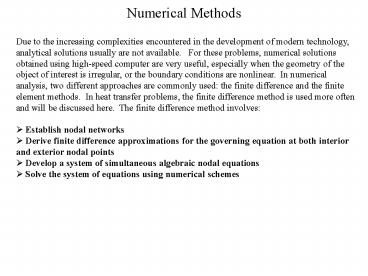Numerical Methods - PowerPoint PPT Presentation
1 / 12
Title:
Numerical Methods
Description:
... n m-1,n Dy Dx m- ,n intermediate points m+ ,n x=mDx, y=nDy The nodal equations derived previously are valid for all interior points satisfying the steady ... – PowerPoint PPT presentation
Number of Views:52
Avg rating:3.0/5.0
Title: Numerical Methods
1
Numerical Methods
- Due to the increasing complexities encountered in
the development of modern technology, analytical
solutions usually are not available. For these
problems, numerical solutions obtained using
high-speed computer are very useful, especially
when the geometry of the object of interest is
irregular, or the boundary conditions are
nonlinear. In numerical analysis, two different
approaches are commonly used the finite
difference and the finite element methods. In
heat transfer problems, the finite difference
method is used more often and will be discussed
here. The finite difference method involves - Establish nodal networks
- Derive finite difference approximations for the
governing equation at both interior and exterior
nodal points - Develop a system of simultaneous algebraic nodal
equations - Solve the system of equations using numerical
schemes
2
The Nodal Networks
The basic idea is to subdivide the area of
interest into sub-volumes with the distance
between adjacent nodes by Dx and Dy as shown. If
the distance between points is small enough, the
differential equation can be approximated locally
by a set of finite difference equations. Each
node now represents a small region where the
nodal temperature is a measure of the average
temperature of the region. Example
Dx
m,n1
m-1,n
m1, n
m,n
Dy
m,n-1
m½,n
m-½,n intermediate points
xmDx, ynDy
3
Finite Difference Approximation
4
Finite Difference Approximation (cont.)
5
Finite Difference Approximation (cont.)
6
A System of Algebraic Equations
- The nodal equations derived previously are valid
for all interior points satisfying the steady
state, no generation heat equation. For each
node, there is one such equation. - For example for nodal point m3, n4, the
equation is - T2,4 T4,4 T3,3 T3,5 - 4T3,4 0
- T3,4(1/4)(T2,4 T4,4 T3,3 T3,5)
- Nodal relation table for exterior nodes
(boundary conditions) can be found in standard
heat transfer textbooks. (ex. F.P. Incropera
D.P. DeWitt, Introduction to Heat Transfer.) - Derive one equation for each nodal point
(including both interior and exterior points) in
the system of interest. The result is a system
of N algebraic equations for a total of N nodal
points.
7
Matrix Form
A total of N algebraic equations for the N nodal
points and the system can be expressed as a
matrix formulation ATC
8
Numerical Solutions
- Matrix form ATC.
- From linear algebra A-1ATA-1C,
TA-1C - where A-1 is the inverse of matrix A. T is
the solution vector. - Matrix inversion requires cumbersome numerical
computations and is not efficient if the order of
the matrix is high (gt10) - Gauss elimination method and other matrix
solvers are usually available in many numerical
solution package. For example, Numerical
Recipes by Cambridge University Press or their
web source at www.nr.com. - For high order matrix, iterative methods are
usually more efficient. The famous Jacobi
Gauss-Seidel iteration methods will be introduced
in the following.
9
Iteration
Replace (k) by (k-1) for the Jacobi iteration
- (k) - specify the level of the iteration, (k-1)
means the present level and (k) represents the
new level. - An initial guess (k0) is needed to start the
iteration. - By substituting iterated values at (k-1) into
the equation, the new values at iteration (k) can
be estimated - The iteration will be stopped when
max?Ti(k)-Ti(k-1)???, where ? specifies a
predetermined value of acceptable error
10
Example
Solve the following system of equations using (a)
the Jacobi methos, (b) the Gauss Seidel iteration
method.
(a) Jacobi method use initial guess X0Y0Z01,
stop when max?Xk-Xk-1,Yk-Yk-1,Zk-Zk-1? ?
0.1 First iteration X1 (11/4) - (1/2)Y0 -
(1/4)Z0 2 Y1 (3/2) (1/2)X0 2 Z1 4 - (1/2)
X0 - (1/4)Y0 13/4
11
Example (cont.)
Second iteration use the iterated values X12,
Y12, Z113/4 X2 (11/4) - (1/2)Y1 - (1/4)Z1
15/16 Y2 (3/2) (1/2)X1 5/2 Z2 4 - (1/2)
X1 - (1/4)Y1 5/2 Final solution 1.014,
2.02, 2.996 Exact solution 1, 2, 3
12
Example (cont.)
(b) Gauss-Seidel iteration Substitute the
iterated values into the iterative process
immediately after they are computed.
Immediate substitution































